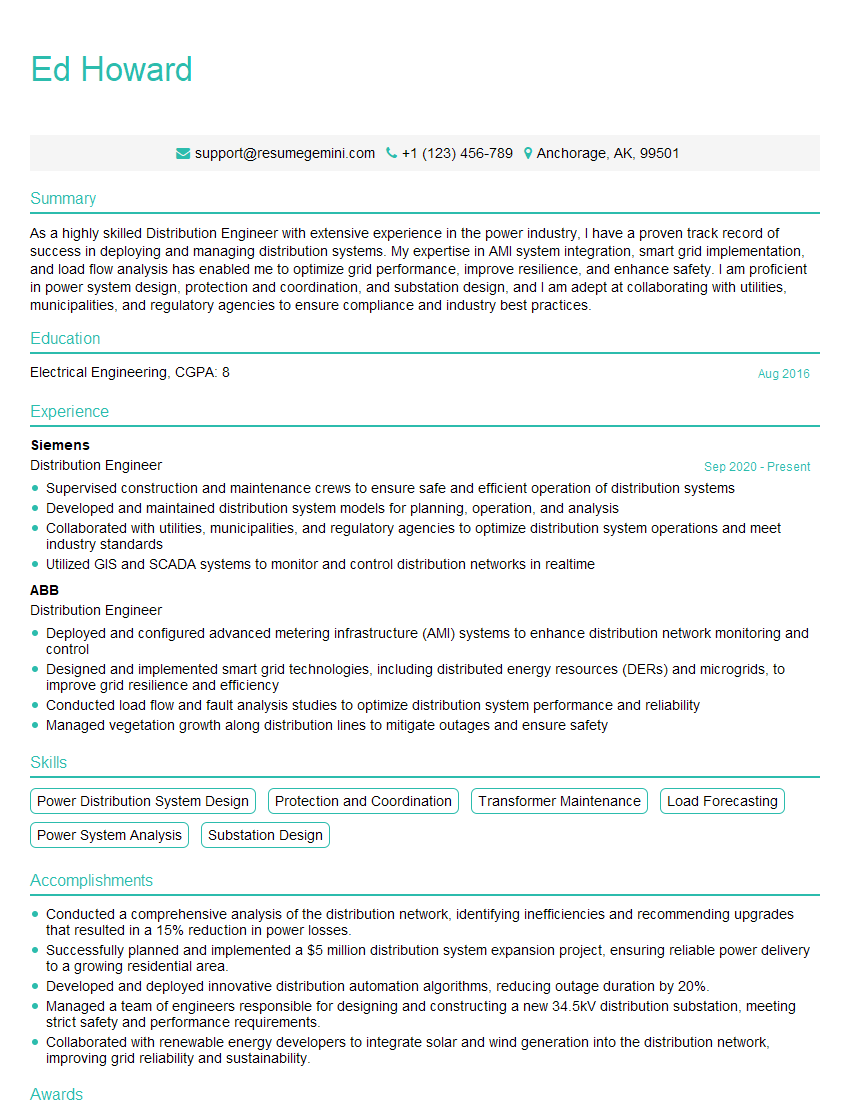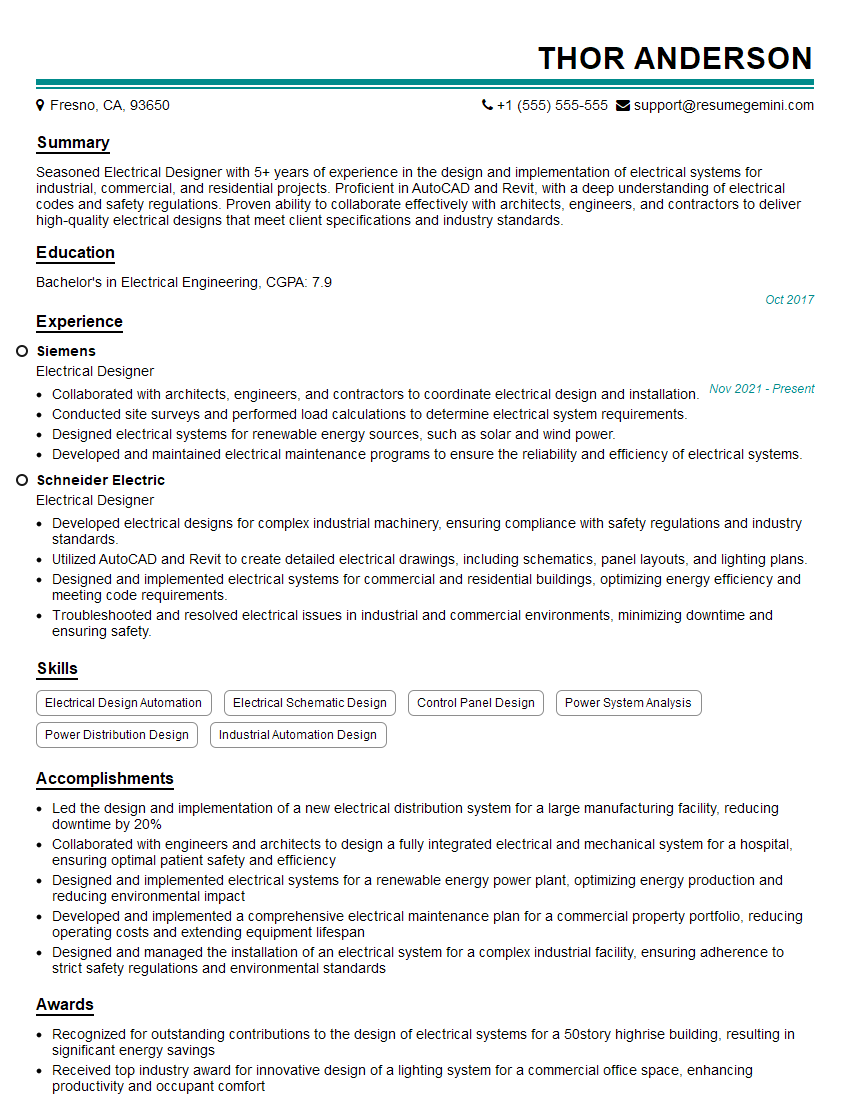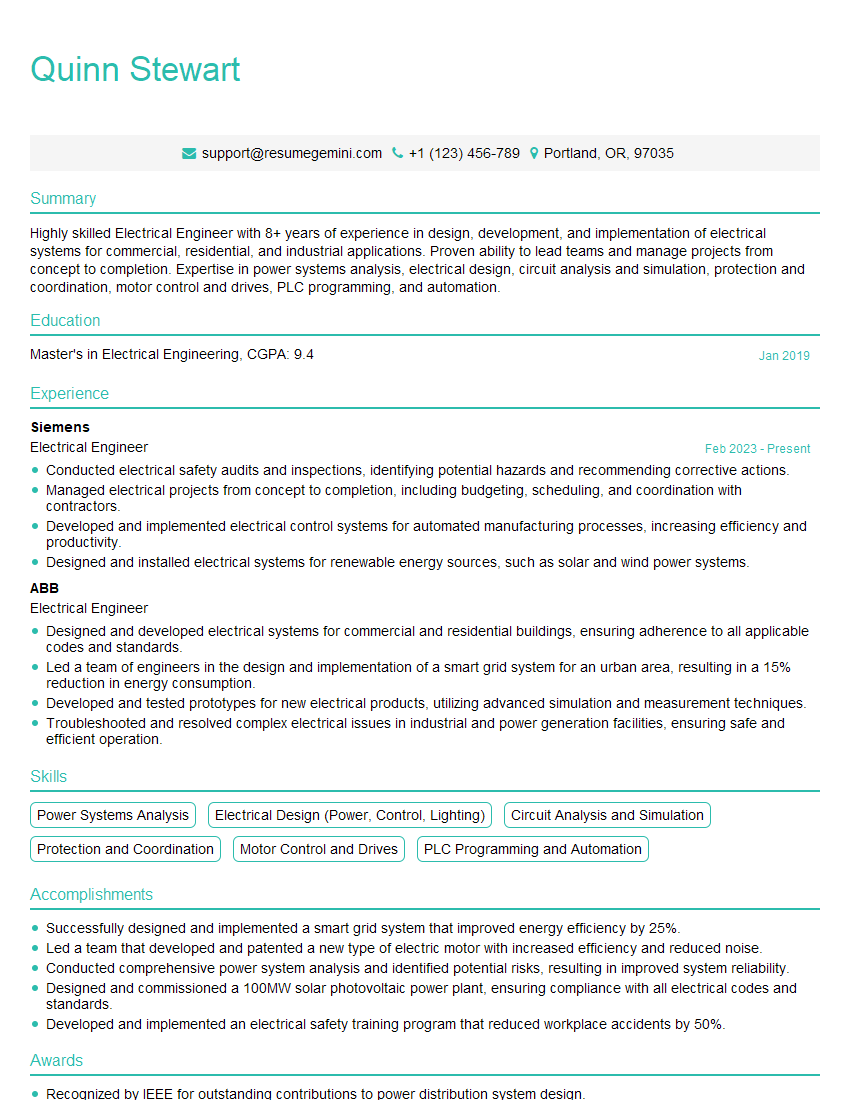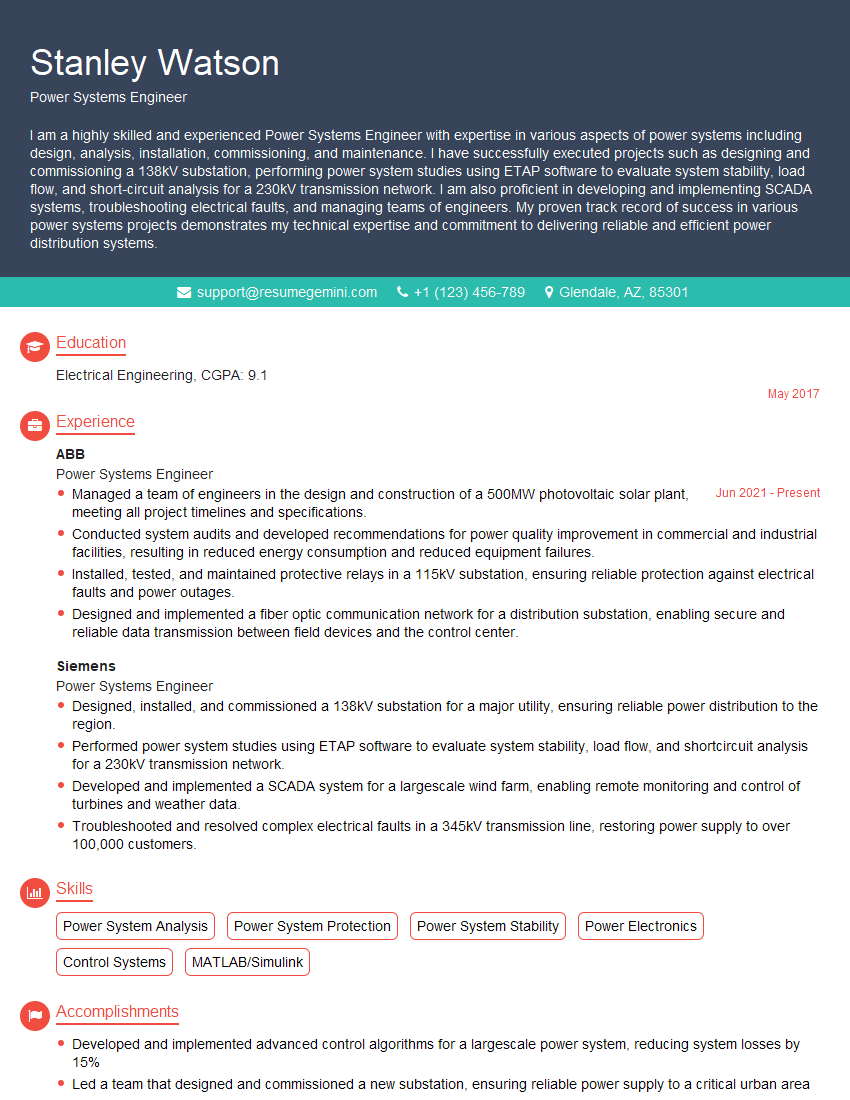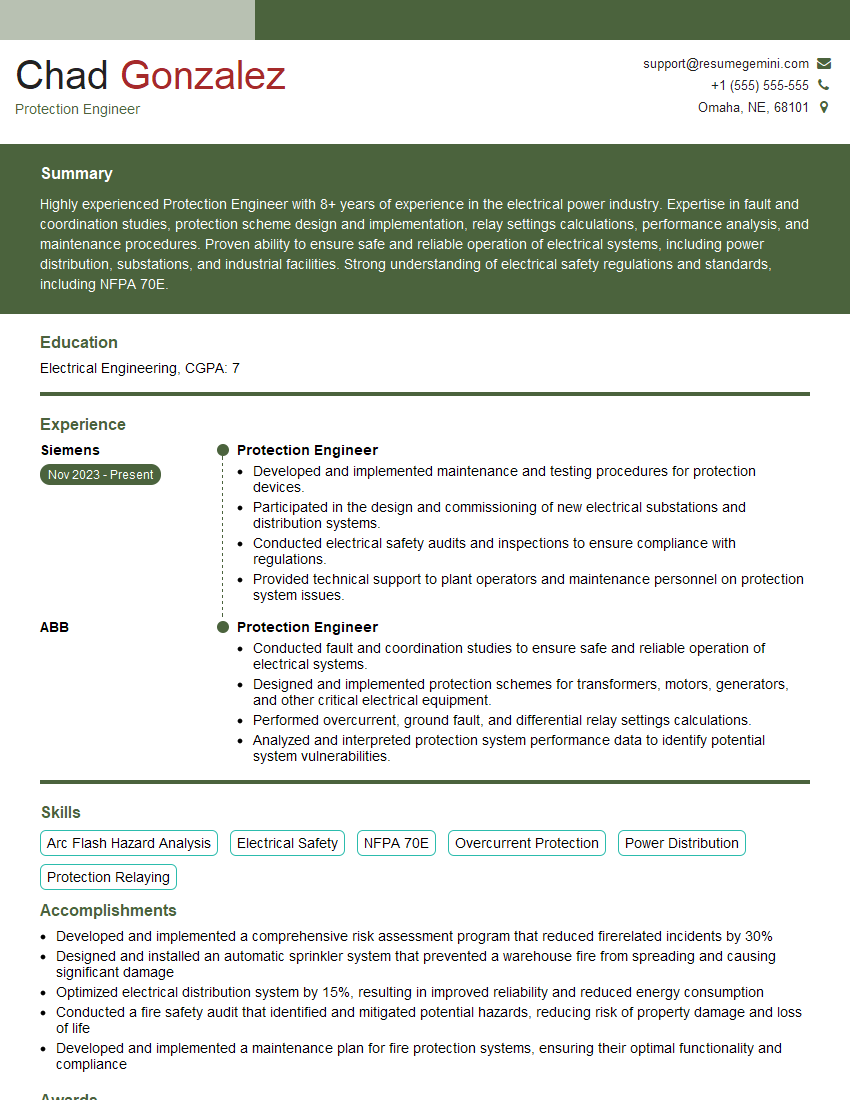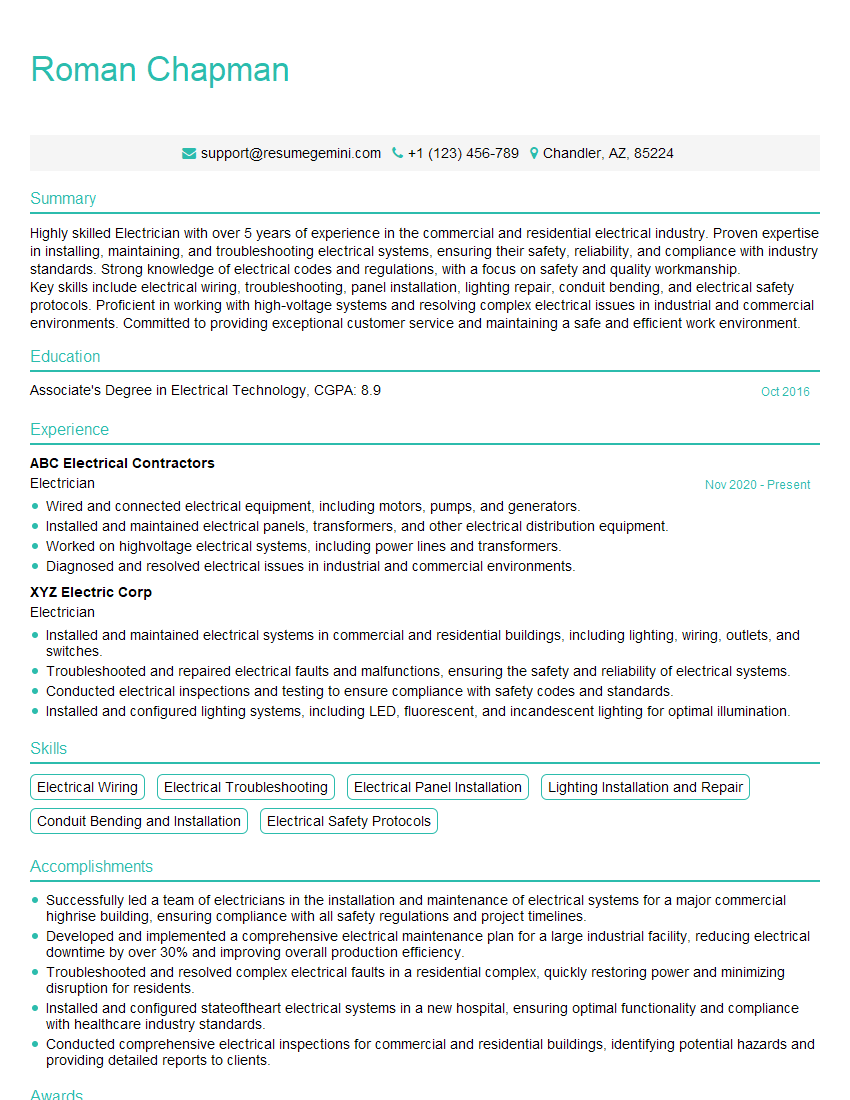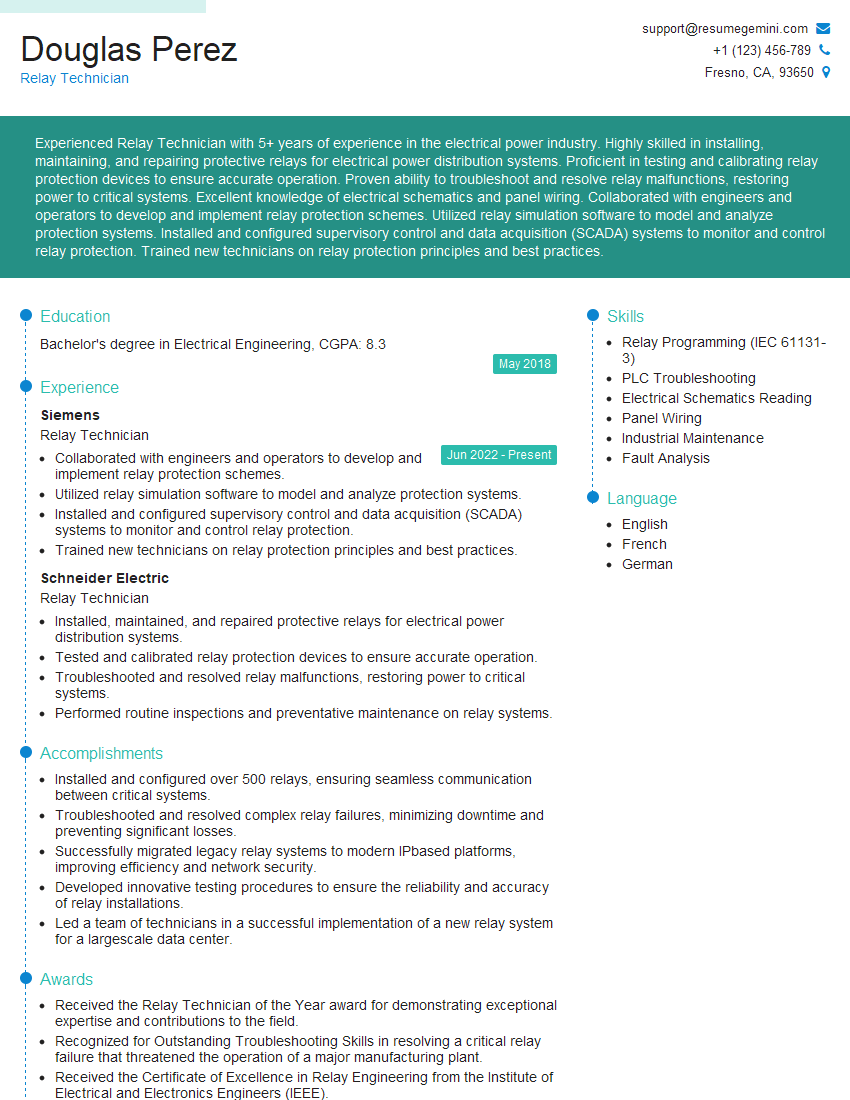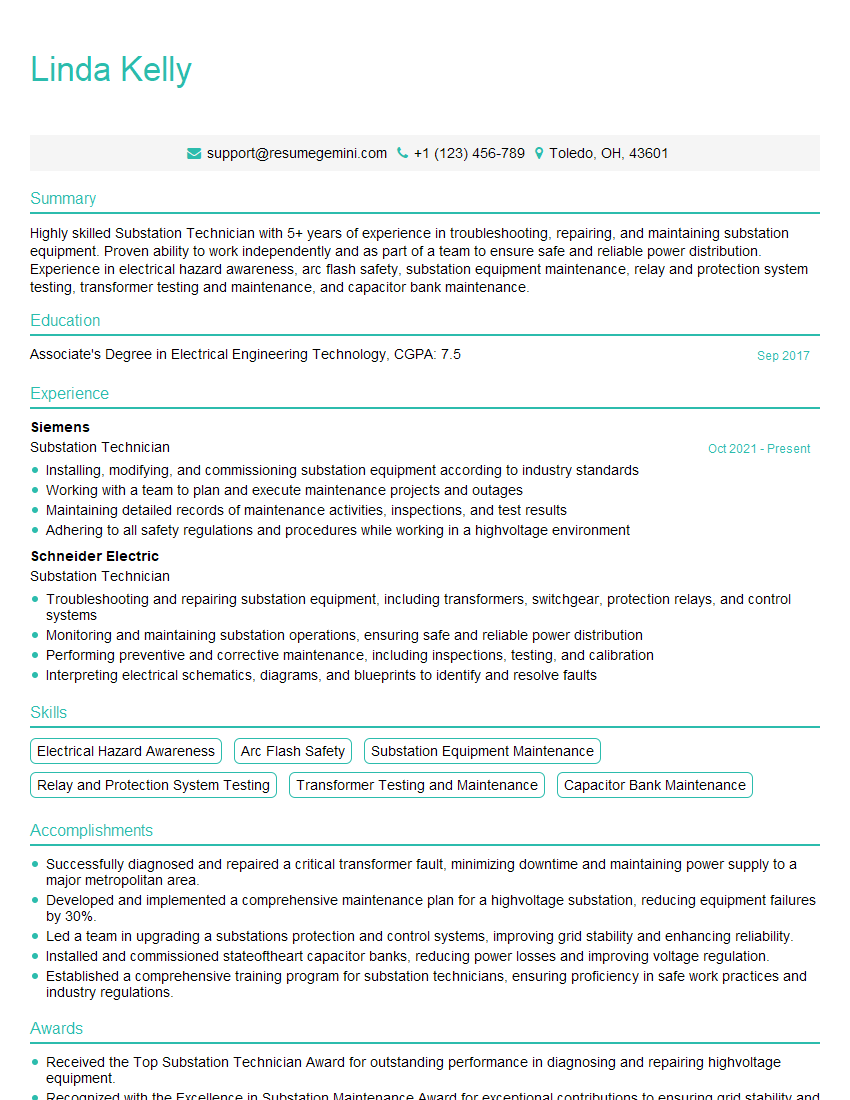Every successful interview starts with knowing what to expect. In this blog, we’ll take you through the top Circuit Breakers and Fuses interview questions, breaking them down with expert tips to help you deliver impactful answers. Step into your next interview fully prepared and ready to succeed.
Questions Asked in Circuit Breakers and Fuses Interview
Q 1. Explain the difference between a circuit breaker and a fuse.
Both circuit breakers and fuses are safety devices designed to protect electrical circuits from overcurrent, but they operate differently. A fuse is a one-time use device; once it blows (melts) due to excessive current, it must be replaced. Think of it like a sacrificial lamb – it protects the circuit by self-destructing. A circuit breaker, on the other hand, is a reusable device. It can be reset after tripping, allowing it to interrupt and restore power multiple times. It’s like a smart switch that automatically cuts off the power when something goes wrong and can be flipped back on after the problem is addressed.
In essence, the key difference lies in their reusability. Fuses offer a simpler, less expensive solution for low-cost applications, while circuit breakers provide a more convenient and potentially longer-lasting protection mechanism for higher-cost equipment and more complex systems.
Q 2. Describe the operating principle of a thermal circuit breaker.
A thermal circuit breaker uses the heat generated by excessive current to trip the breaker. Inside the breaker is a bimetallic strip – a strip of metal composed of two different metals with different thermal expansion coefficients. When excessive current flows, the strip heats up. Because of the different expansion rates of the metals, the strip bends, triggering a mechanical mechanism that breaks the circuit. Imagine a thermostat; when it gets too hot, it bends and cuts off the power. Similarly, the bimetallic strip bends and physically disconnects the circuit when the current exceeds a safe level.
This type of breaker is commonly found in lower-current applications due to its simple construction and lower cost. However, it has a slower response time compared to other types of circuit breakers, making it less suitable for applications requiring rapid fault detection.
Q 3. What are the different types of circuit breakers?
Circuit breakers come in various types, categorized by their tripping mechanism:
- Thermal Circuit Breakers: As explained earlier, these use a bimetallic strip to detect overcurrent.
- Magnetic Circuit Breakers: These utilize an electromagnet. When the current surpasses a certain threshold, the magnetic field generated becomes strong enough to trip a mechanical mechanism and open the circuit. They’re faster than thermal breakers.
- Thermal-Magnetic Circuit Breakers: These are the most common type. They combine both thermal and magnetic tripping mechanisms for better protection across a wider range of fault currents. They provide both fast response to high currents (magnetic) and protection against lower, prolonged overloads (thermal).
- Electronic Circuit Breakers: These use sophisticated electronics to detect overcurrents, faults, and other issues, providing advanced features like remote monitoring and control. They often incorporate microprocessors to analyze current patterns and optimize protection strategies.
Furthermore, breakers are also classified based on their installation type (e.g., molded case, air circuit breaker), voltage rating, and other operational characteristics.
Q 4. Explain the concept of interrupting rating of a circuit breaker.
The interrupting rating of a circuit breaker specifies the maximum fault current it can safely interrupt without causing damage to itself or posing a safety hazard. It’s expressed in amperes (A) and indicates the breaker’s ability to quickly and safely clear a short circuit. This is crucial for safety because a short circuit can generate extremely high currents that can cause fires, equipment damage, or even explosions.
For example, a breaker with an interrupting rating of 10,000A can safely interrupt a fault current up to 10,000A. Selecting a breaker with a sufficiently high interrupting rating is essential to ensure the safety of personnel and equipment. The rating must always be greater than the maximum fault current expected in the system. It’s often determined by a fault current study.
Q 5. What are the factors to consider when selecting a circuit breaker?
Selecting the right circuit breaker involves considering several critical factors:
- Amperage rating: This should match the circuit’s load current to prevent nuisance tripping. The breaker’s rating should be slightly higher than the anticipated current draw.
- Interrupting rating: This should exceed the maximum short circuit current expected in the system to ensure safe interruption of faults.
- Voltage rating: This must match the system’s voltage.
- Type of trip mechanism: The choice depends on the application’s requirements for speed of response and fault detection.
- Installation type: Consider the type of enclosure and mounting style required for the specific application.
- Environmental considerations: Factors like temperature, humidity, and ambient conditions can affect the breaker’s performance.
- Cost: Balancing cost with required safety and performance is crucial.
Q 6. How do you test a circuit breaker?
Testing a circuit breaker depends on the type and the level of testing required. Routine checks are typically visual inspections for damage or loose connections. More rigorous testing might involve using specialized equipment.
Visual inspection: Check for signs of overheating, damage to the casing, loose wiring, or any signs of arcing. Functional testing: This might involve manually tripping the breaker to ensure it operates correctly. More advanced testing equipment can simulate fault conditions and measure the breaker’s response time and interrupting capacity. Never attempt to test a circuit breaker without proper training and safety precautions. Always follow the manufacturer’s instructions and applicable safety regulations.
Q 7. Explain the different types of fuses.
Fuses also come in various types:
- High-rupturing capacity (HRC) fuses: Designed to interrupt high fault currents safely.
- Slow-blow fuses: Allow momentary current surges above the rated current without blowing, protecting circuits from minor overloads. Think of them as having a bit more tolerance for short bursts.
- Fast-blow fuses: Provide quick protection against short circuits.
- Cartridge fuses: These are cylindrical fuses with enclosed elements.
- Blade fuses: These have flat blades at each end for connection.
The type of fuse chosen depends on the specific application and the type of protection required. Selecting the correct fuse type is crucial for preventing equipment damage and ensuring system safety.
Q 8. What is the purpose of a fuse?
A fuse is a low-cost, overcurrent protection device that acts as the first line of defense in an electrical circuit. Think of it as a sacrificial device; it’s designed to melt and break the circuit when the current exceeds its rated value, thus preventing damage to equipment and preventing fires. This happens because the fuse’s internal wire is designed to melt at a specific amperage. Once the wire melts, the circuit is interrupted, protecting connected components.
Imagine a fuse as a tiny, controlled explosion. When an overload occurs, instead of causing a larger, more dangerous problem, the fuse blows, containing the damage to itself.
Q 9. How do you determine the appropriate fuse rating for a given application?
Selecting the right fuse rating is crucial for safety and proper equipment function. You must consider the maximum current draw of the device or circuit being protected. The fuse rating should be slightly higher than this maximum current to allow for normal operating current fluctuations, but not so high that it fails to protect against overloads. Consult the equipment’s documentation for the recommended fuse rating. For example, a device drawing 10 amps continuously might require a 15-amp fuse (allowing for a small margin), but never a lower rated fuse.
Improper fuse selection can lead to two dangerous situations: A fuse rated too high might not blow during an overload, causing equipment damage or fire. A fuse rated too low might blow unnecessarily during normal operation, causing nuisance tripping.
Always use fuses that meet the appropriate safety standards (e.g., UL listed).
Q 10. What are the safety precautions when working with circuit breakers and fuses?
Safety is paramount when working with circuit breakers and fuses. Always follow these precautions:
- Turn off the power: Before working on any electrical system, always disconnect the power source completely. Use a lockout/tagout system to prevent accidental energization.
- Use appropriate PPE: Wear safety glasses, insulated gloves, and non-conductive footwear to prevent electrical shock.
- Inspect equipment: Before replacing a fuse or resetting a breaker, visually inspect it for any damage. A severely charred fuse or a breaker exhibiting signs of arcing requires professional attention.
- Never work alone: Have a colleague nearby to assist in case of an emergency.
- Understand the system: Thoroughly understand the circuit’s layout and voltage levels before working on it.
Remember: Electricity is dangerous. If you are not comfortable or unsure about any aspect, consult a qualified electrician.
Q 11. Explain the concept of arc flash and its relation to circuit breakers.
Arc flash is a dangerous electrical hazard resulting from a short circuit or other fault in an electrical system. It’s a powerful, explosive release of energy in the form of an arc (a high-temperature electric current). The intense heat and pressure generated can cause severe burns, hearing loss, and even death. Circuit breakers play a critical role in mitigating arc flash hazards. Their fast response times help minimize the duration of the arc, thus reducing its severity.
Modern circuit breakers incorporate features like arc flash reduction technology to help minimize the energy released during an arc fault, making them safer for personnel.
Arc flash analysis is essential in high-voltage systems to assess the potential risks and implement appropriate safety measures, including protective clothing and procedures.
Q 12. Describe the various protective relays used in conjunction with circuit breakers.
Protective relays are intelligent devices used in conjunction with circuit breakers to provide more sophisticated overcurrent protection and fault detection. They monitor various electrical parameters (current, voltage, frequency, etc.) and trip the circuit breaker when a fault condition is detected. Different relay types offer various protection schemes:
- Overcurrent relays: Protect against excessive currents due to overloads or short circuits.
- Differential relays: Detect internal faults within transformers or generators.
- Distance relays: Measure the impedance to a fault and trip the breaker to isolate the faulted section of a transmission line.
- Ground fault relays: Detect ground faults in electrical systems.
The choice of relay depends on the specific application and the type of protection required. Relays significantly improve the selectivity and speed of fault clearing, minimizing damage and downtime.
Q 13. How do you troubleshoot a tripped circuit breaker?
Troubleshooting a tripped circuit breaker requires a systematic approach:
- Safety First: Ensure the power is off before any inspection.
- Visual Inspection: Check the breaker for any signs of damage (charring, arcing). If severe damage is visible, do not attempt to reset the breaker – call a qualified electrician.
- Check for Overloads: Determine if the circuit is overloaded. Too many appliances drawing current from one circuit can cause a trip. Unplug non-essential devices and try resetting the breaker.
- Check for Short Circuits: Inspect the wiring and appliances connected to the circuit for signs of damage or short circuits (bare wires, frayed cords).
- Test the Circuit: Use a multimeter to check for continuity in the circuit and to ensure that there aren’t any shorts.
- Reset the Breaker: If no faults are found, try resetting the breaker. If it trips immediately again, there is likely a fault in the circuit that needs professional attention.
Remember, if you are uncertain, call a qualified electrician. Improper troubleshooting can be dangerous.
Q 14. What is the difference between a slow-blow and a fast-blow fuse?
Slow-blow and fast-blow fuses differ in their response time to overcurrent conditions. A fast-blow fuse responds quickly to surges and short circuits, protecting sensitive electronic components from sudden current spikes. They have a very low tolerance for current above their rating. Imagine a fuse that acts like a quick, decisive safety mechanism, immediately cutting off the power to prevent harm.
A slow-blow fuse, also known as a time-delay fuse, can tolerate brief overcurrents caused by motor starting or inrush currents. These surges are common with motors, which draw higher current initially than during continuous operation. Slow-blow fuses allow these temporary overcurrents to pass without blowing, while still protecting against sustained overloads. Think of this as a more patient safety measure, allowing temporary bursts of current but cutting off if it becomes consistently high.
The choice between slow-blow and fast-blow depends on the application. Electronic devices usually need fast-blow fuses, whereas motors and other inductive loads often require slow-blow fuses.
Q 15. Explain the concept of coordination between fuses and circuit breakers.
Coordination between fuses and circuit breakers, often found in electrical distribution systems, ensures that the right protective device operates during a fault. It’s like having a team where each member has a specific role. The goal is to protect downstream equipment while minimizing disruption. Ideally, the device closest to the fault clears it first, protecting more sensitive components further along the line. This is achieved through careful selection of fuse ratings and circuit breaker tripping characteristics (such as their time-current curves). For example, you might have a high-capacity fuse protecting the main incoming supply, followed by several lower-capacity fuses protecting individual circuits. If a fault occurs on one of those circuits, the corresponding fuse blows, preventing the fault from spreading to other circuits and protecting the main fuse from unnecessary tripping.
Consider a scenario with a main fuse rated for 100A and several 15A fuses protecting individual circuits. A fault causing a 20A overcurrent on a single circuit will only blow the corresponding 15A fuse, leaving the main fuse intact and the rest of the system operational. Without coordination, a high fault current could blow all fuses simultaneously, causing a major outage and potentially damaging the main supply.
Career Expert Tips:
- Ace those interviews! Prepare effectively by reviewing the Top 50 Most Common Interview Questions on ResumeGemini.
- Navigate your job search with confidence! Explore a wide range of Career Tips on ResumeGemini. Learn about common challenges and recommendations to overcome them.
- Craft the perfect resume! Master the Art of Resume Writing with ResumeGemini’s guide. Showcase your unique qualifications and achievements effectively.
- Don’t miss out on holiday savings! Build your dream resume with ResumeGemini’s ATS optimized templates.
Q 16. What is a miniature circuit breaker (MCB)?
A Miniature Circuit Breaker (MCB) is an electromechanical switch that automatically trips when a fault current exceeds its rated capacity. Think of it as a sophisticated, resettable fuse. It’s designed to protect low-voltage circuits in residential and commercial applications against overcurrent conditions such as short circuits and overloads. MCBs are smaller and more easily replaceable than their larger counterparts, making them ideal for installations with many individual circuits. Unlike fuses which must be replaced after tripping, MCBs can be reset after the fault is cleared. They typically operate through a thermal mechanism (responding to sustained overcurrents) and/or a magnetic mechanism (responding to very high fault currents), ensuring rapid disconnection during short circuits.
Imagine an MCB protecting your home’s lighting circuit. If a short circuit occurs because of damaged wiring, the MCB will instantly detect the excessive current and trip, preventing a fire or other damage. Then, after the fault is rectified, the MCB can be reset to restore power.
Q 17. What is an earth leakage circuit breaker (ELCB)?
An Earth Leakage Circuit Breaker (ELCB), also known as a Ground Fault Circuit Interrupter (GFCI), protects against electric shock caused by earth leakage currents. Unlike MCBs which primarily respond to overcurrents in the circuit, ELCBs detect even small current imbalances between the live and neutral conductors. This imbalance indicates that a current is leaking to earth, potentially through a person touching a faulty appliance or exposed wiring. ELCBs function by constantly monitoring this balance; if the imbalance exceeds a preset threshold, the breaker trips, preventing shock and potentially lethal current from flowing to ground. It’s a crucial safety device, especially in damp areas like bathrooms and kitchens. They are frequently used in conjunction with MCBs for comprehensive protection.
For example, if you accidentally touch a faulty appliance with a wet hand, a small current might leak to the ground through your body. An ELCB would detect this leakage current, immediately interrupt the power supply, preventing a potentially fatal electric shock. This is very different from an MCB, which only detects a significant current flowing through the circuit itself.
Q 18. Explain the different types of fault currents.
Fault currents are currents that flow under abnormal conditions, resulting in potentially dangerous situations. Several types exist:
- Short Circuit Current: This occurs when a low-impedance path is created between two conductors, allowing very high currents to flow. It often results from damaged insulation or accidental contact between wires. Think of it as a direct short across the supply.
- Overload Current: This is a sustained current that exceeds the rated capacity of a circuit. It’s usually caused by exceeding the designed load of an electrical system (for example, connecting too many appliances to one circuit). Unlike short circuits which are instantaneous, this develops more gradually.
- Earth Leakage Current: This is a current flowing to the ground, bypassing the intended circuit path. It indicates a fault involving contact with earth, posing a significant shock hazard.
Understanding these types is essential for selecting appropriate protective devices. Short circuit currents require fast-acting protection, while overload currents may necessitate time-delayed protection.
Q 19. How do circuit breakers protect against overcurrent and short circuits?
Circuit breakers protect against overcurrent and short circuits by rapidly interrupting the current flow when a fault is detected. For overcurrent, they use either thermal or magnetic mechanisms (or a combination). The thermal mechanism responds to sustained overloads by heating a bimetallic strip, which bends and trips the breaker. The magnetic mechanism responds to instantaneous high currents (short circuits) by generating a magnetic field strong enough to trip the breaker directly. Both mechanisms ensure protection against different types of overcurrents.
In the event of a short circuit, the high current generates a strong magnetic field that instantly trips the magnetic mechanism, effectively isolating the faulty circuit. Similarly, if there’s a persistent overload, the sustained high current heats the bimetallic strip, causing it to bend and trip the thermal mechanism after a certain time delay. These mechanisms ensure the safety of the circuit and the equipment connected to it.
Q 20. Describe the different types of arc quenching methods in circuit breakers.
Arc quenching is crucial in circuit breakers, as the high currents during a fault can generate extremely hot and destructive electrical arcs. Several methods are used to extinguish these arcs:
- Air Blast: High-pressure air is forcefully blown across the arc, disrupting its continuity and cooling the plasma to below the arc’s sustaining temperature.
- Vacuum Interruption: The arc is drawn into a vacuum chamber, where the lack of air prevents its formation and sustenance.
- Oil Immersion: The arc is submerged in oil, which quenches the arc by cooling and isolating it.
- SF6 (Sulfur Hexafluoride) Gas Interruption: This gas has excellent arc-quenching properties due to its high dielectric strength and ability to absorb a lot of heat. It’s used in high-voltage circuit breakers.
The choice of arc quenching method depends on factors like voltage level, current rating, and environmental considerations. For example, SF6 is frequently used in high-voltage applications, while air blast is common in medium-voltage systems, and vacuum interruption is popular in low-voltage circuit breakers because it offers fast operation and minimal maintenance.
Q 21. What are the limitations of using fuses?
While fuses are simple and effective protective devices, they do have limitations:
- One-time use: Fuses must be replaced after tripping, causing downtime and requiring immediate attention during a fault. This can be particularly inconvenient in critical systems.
- Time-current characteristic limitations: Fuses have specific time-current curves that might not be perfectly matched to the protected equipment’s characteristics. Improper coordination with other protective devices can lead to unnecessary blowing of multiple fuses.
- Limited interrupting capacity: Fuses have a limited ability to interrupt fault currents, and selecting an inappropriate rating could lead to fuse failure and potential damage to the equipment.
- Voltage limitation: Fuses are designed for specific voltage ranges, exceeding those ranges can result in hazardous scenarios.
These limitations explain why circuit breakers are often preferred in many modern applications, especially those requiring frequent fault clearing, minimal downtime, and precise protection coordination.
Q 22. What are the advantages and disadvantages of using solid-state relays?
Solid-state relays (SSRs) are electronic switches that use a semiconductor device, like a thyristor, to control a larger electrical load. They offer several advantages over electromechanical relays, but also have some drawbacks.
- Advantages:
- Longer lifespan: SSRs have no moving parts, resulting in a much longer operational life compared to mechanical relays, reducing maintenance needs.
- Faster switching speeds: They switch on and off significantly faster than electromechanical relays, making them suitable for high-frequency applications.
- Silent operation: No clicking or humming sounds, ideal for noise-sensitive environments.
- Higher switching currents: They can handle significantly higher currents than smaller mechanical relays.
- Improved control: Offer greater control capabilities, including dimming and phase control for AC loads.
- Disadvantages:
- Sensitivity to voltage surges: SSRs are susceptible to damage from voltage transients and require surge protection.
- Heat dissipation: They generate heat during operation and may require heat sinks for high-power applications.
- Higher initial cost: Generally more expensive than comparable electromechanical relays.
- Limited overload capacity: Though improving, their overload tolerance is still usually less than that of a properly sized mechanical relay.
- Potential for latch-up: Under certain fault conditions, some SSRs can exhibit latch-up, causing them to remain permanently on or off.
For example, SSRs are frequently used in industrial automation systems for controlling motors and heaters, where their speed and long lifespan are beneficial. However, their vulnerability to voltage spikes necessitates the incorporation of surge protection devices in such applications. Consider carefully the cost and operating environment when choosing between SSRs and mechanical relays.
Q 23. Explain the importance of regular maintenance for circuit breakers and fuses.
Regular maintenance for circuit breakers and fuses is crucial for safety and reliable operation. Neglecting maintenance can lead to equipment failure, potential fire hazards, and costly downtime.
- Visual inspection: Regularly check for signs of damage, overheating (discoloration, warping), loose connections, or corrosion. This is especially critical after events such as power surges or electrical storms.
- Testing: Periodically test circuit breakers using appropriate testing equipment (e.g., insulation testers, digital multimeters) to ensure proper operation. For fuses, visual inspection for blown elements is sufficient. Testing tools are readily available and even some multimeters can test blown fuses directly.
- Cleaning: Keep the surrounding area clean and free of debris to prevent overheating and ensure proper ventilation.
- Calibration: For high-precision applications or critical systems, professional calibration of circuit breakers is recommended to verify their accuracy.
- Documentation: Maintain detailed records of all inspections, tests, and maintenance activities. This helps track the condition of the equipment and facilitates preventative maintenance.
Imagine a scenario where a corroded connection on a circuit breaker leads to overheating and a subsequent fire. Regular visual inspections and diligent maintenance could have easily prevented this catastrophic incident. Following these simple maintenance steps ensures the continuous, reliable operation of critical electrical equipment and helps prevent hazardous situations.
Q 24. How do you interpret a circuit breaker’s trip curve?
A circuit breaker’s trip curve is a graph illustrating the relationship between the magnitude of the fault current and the time it takes for the breaker to trip. Understanding the trip curve is essential for selecting the appropriate breaker for a given application.
The x-axis usually represents time (typically in seconds or milliseconds), while the y-axis represents the current (usually in amperes). The curve shows the time it takes the breaker to trip at different fault current levels. Curves are typically categorized as ‘long-time delay’, ‘short-time delay’, and ‘instantaneous’.
- Long-time delay: The breaker trips slowly for small overcurrents to allow for temporary overloads (e.g., motor starting).
- Short-time delay: The breaker trips faster for moderate overcurrents.
- Instantaneous: The breaker trips immediately at very high fault currents.
By examining the trip curve, engineers can determine if a specific breaker will provide adequate protection against overloads and short circuits for a particular electrical system. For instance, a motor starting circuit might require a breaker with a longer trip time to prevent nuisance tripping, whereas a sensitive electronic equipment branch might require one with a faster tripping characteristic for enhanced protection.
Q 25. What are the common causes of circuit breaker failure?
Circuit breaker failures can stem from various causes, impacting safety and system reliability. Understanding these causes is crucial for preventative maintenance.
- Overheating: Prolonged exposure to high currents or faults can cause excessive heat generation, leading to component damage or arc formation.
- Arc Flash: High-current arcs can severely damage internal components.
- Mechanical wear: Repeated operation, especially in high-vibration environments, can wear down mechanical parts.
- Corrosion: Exposure to moisture or corrosive substances can damage contacts and internal components.
- Loose connections: Poor electrical connections increase resistance and heat generation.
- Calibration drift: Over time, the breaker’s tripping characteristics might deviate from the specified values.
- Environmental factors: Excessive dust, dirt, or extreme temperatures can affect performance.
For instance, a faulty connection in a panel board, leading to a high resistance, may cause overheating, potentially damaging the circuit breaker and potentially creating a fire hazard. Regular inspections and preventative measures, such as cleaning and tightening connections, are essential to mitigate these risks.
Q 26. Describe different methods for testing fuse integrity.
Testing fuse integrity ensures they function correctly and protect the circuit. Different methods are used depending on the fuse type and available tools.
- Visual inspection: The simplest method; check for a broken filament or any physical damage to the fuse body. This method is sufficient for many applications, particularly for smaller fuses where a visual check for an intact filament is straightforward.
- Continuity test (multimeter): A multimeter in continuity mode can check for an unbroken circuit through the fuse. A reading of 0 ohms indicates a good fuse; an infinite reading confirms a blown fuse. This is generally a rapid method, allowing for the screening of multiple fuses.
- Specialized fuse testers: For high-voltage or special fuses, dedicated fuse testers may be needed to apply a controlled current and monitor the voltage drop, determining whether the fuse is functioning within its specification.
Consider a scenario where you’re troubleshooting a malfunctioning circuit. A quick visual inspection reveals a blown fuse. After replacing the fuse, the continuity test confirms the correct functionality of the new fuse before powering up the circuit again. A simple method, but critical for safety and preventing damage.
Q 27. How does a vacuum circuit breaker work?
Vacuum circuit breakers operate by interrupting an electrical arc within a vacuum chamber. This design provides several advantages over other breaker technologies.
When a fault occurs and the circuit breaker needs to interrupt the current, the contacts within the vacuum chamber separate. An arc forms briefly between the separating contacts. Because the vacuum prevents the formation of an ionized gas path that would sustain the arc (as in air), the arc quickly extinguishes, allowing the circuit breaker to interrupt the high fault current safely and rapidly. The absence of an arc-quenching medium, such as oil or SF6, also contributes to reduced environmental impact and maintenance requirements.
This rapid arc interruption and lack of insulating gas make vacuum circuit breakers extremely effective for high-voltage applications where quick, reliable fault clearance is paramount. They are common in medium to high voltage electrical distribution systems across many industries.
Q 28. What is the role of a current transformer (CT) in circuit breaker protection?
A current transformer (CT) is a crucial component in circuit breaker protection systems. It measures the current flowing through a conductor, providing a scaled-down replica of the current to the circuit breaker’s protection relay.
The protection relay monitors the CT’s output. If a fault current exceeds a predetermined threshold, the relay signals the circuit breaker to trip, isolating the faulted section of the circuit and preventing damage to equipment and ensuring safety. CTs are essential as they allow for accurate measurement of high currents without requiring the relay to handle the full fault current directly.
For instance, in a power distribution system, CTs are used in conjunction with overcurrent relays to protect transformers and transmission lines. The CT provides a safe and efficient way to monitor high currents, enabling the relay to detect and respond to faults quickly, thus protecting the system from damage and minimizing downtime. The accuracy of the CT is essential for the proper operation of the protection system; an inaccurate CT might lead to nuisance tripping or a failure to trip during a real fault.
Key Topics to Learn for Circuit Breakers and Fuses Interview
- Fundamental Principles: Understanding the basic operating principles of both circuit breakers and fuses – how they function to protect electrical circuits from overcurrent.
- Types and Classifications: Familiarize yourself with different types of circuit breakers (e.g., thermal magnetic, electronic) and fuses (e.g., slow-blow, fast-blow) and their respective applications.
- Selection Criteria: Learn how to select appropriate circuit breakers and fuses based on factors like current rating, voltage rating, interrupting capacity, and application requirements.
- Protection Schemes: Understand how circuit breakers and fuses are incorporated into larger protection schemes for electrical systems, including coordination and selectivity.
- Fault Current Calculations: Develop the ability to calculate fault currents and determine the necessary interrupting capacity of protective devices.
- Troubleshooting and Maintenance: Gain practical knowledge on common troubleshooting techniques for faulty circuit breakers and fuses, and routine maintenance procedures.
- Safety Procedures: Understand and emphasize the importance of safety regulations and procedures when working with electrical equipment and protective devices.
- Practical Applications: Explore real-world applications in various industries, such as power distribution, industrial control systems, and residential wiring.
- Standards and Codes: Be familiar with relevant industry standards and codes related to circuit breakers and fuses (e.g., IEC, ANSI).
- Emerging Technologies: Briefly research advancements in circuit breaker and fuse technology, demonstrating an awareness of industry trends.
Next Steps
Mastering the intricacies of circuit breakers and fuses is crucial for career advancement in electrical engineering and related fields. A strong understanding of these protective devices demonstrates essential technical skills and problem-solving abilities highly valued by employers. To significantly enhance your job prospects, crafting a compelling and ATS-friendly resume is key. ResumeGemini is a trusted resource to help you build a professional and impactful resume that highlights your qualifications effectively. Examples of resumes tailored to Circuit Breakers and Fuses expertise are available to further guide you in this process.
Explore more articles
Users Rating of Our Blogs
Share Your Experience
We value your feedback! Please rate our content and share your thoughts (optional).
What Readers Say About Our Blog
This was kind of a unique content I found around the specialized skills. Very helpful questions and good detailed answers.
Very Helpful blog, thank you Interviewgemini team.







